The ethernet to fiber converter is a bidirectional transparent converter that provides Ethernet data signals to fiber optic data signals. Ethernet to fiber converter can transmit Ethernet signals through fiber optic lines to break through the limit of 100 meters of transmission distance, so that Ethernet network coverage is greatly extended. The product features of the Ethernet function transceiver not only self-adaptive network interface, but also support multiple working modes.
1. The role of ethernet to fiber converter
Optical fiber data communication has the characteristics of long communication distance, large communication data capacity and not easy to be interfered. It has been widely used. Optical fiber has penetrated into all walks of life and all levels. The emergence of the device ensures that electrical signals and optical signals can be smoothly converted to each other, and is suitable for telecommunications, radio and television, broadband networks and other Ethernet network environments that require high speed, high data traffic, high performance, and high reliability.
2. Characteristics of ethernet to fiber converter
2.1 With 10/100M network interface self-adaptation, the network interface automatically detects the direct connection/crossover connection mode and automatically adapts.
2.2 Support a variety of working modes: pass-through mode, store-and-forward mode, transceiver mode, and use the toggle switch to set the working mode.
2.3 Disconnection indication function, when the optical fiber or network cable is disconnected, all connections are automatically disconnected.
2.4 It can be powered by external power supply or USB interface, any choice.
2.5 Optical fiber interface FC/SC/ST can be optional, single-mode fiber, multi-mode fiber.
2.6 Provide ultra-low latency data transmission, completely transparent to network protocols.
3. Technical parameters of ethernet to fiber converter
3.1 Interface features: Ethernet port conforms to TCP/IP protocol
3.2 Transmission medium: single-mode/multi-mode (optical fiber), super five shielded twisted pair (network port)
3.3 Electrical interface: DB9 (RS-232 serial port) industrial terminal block (RS-485/422 serial port)
3.4 Lightning protection: lightning protection against surge protection (network port)
3.5 Transmission rate: 10/100M
3.6 Appearance size: 100L*69W*22H mm
3.7 Use environment: temperature: -20℃-60℃, humidity: 5%-95%
3.8 Transmission distance: multi-mode 2KM, single-mode 20KM (40KM, 60KM need to be customized)
3.9 Optical fiber interface: ST, SC, FC interface optional
4. Introduction to ethernet to fiber converter
Users can choose the all-optical port configuration or the optical port hybrid configuration, and the access fiber media can choose single-mode fiber or multi-mode fiber. The switch can support network remote management and local management at the same time to realize the monitoring of port working status and switch settings.
The optical fiber port is especially suitable for the information point access distance beyond the five-category line access distance, the need for anti-electromagnetic interference and the need for communication confidentiality. The applicable fields include: residential FTTH broadband access network; enterprise high-speed optical fiber LAN; high-reliability industrial distribution Control system (DCS); optical fiber digital video surveillance network; hospital high-speed optical fiber LAN; campus network.




















